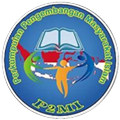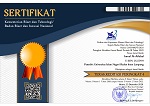SELF-IMPROVEMENT FOR PEOPLE WITH DISABILITIES: A COMMUNITY EMPOWERMENT ENDEAVOUR
Abstract
People with disabilities are those who have limitations in communicating with other individuals. Society’s negative view of people with disabilities still provides limitations, especially in terms of employment, so empowerment in improving the quality of their lives needs to be carried out. This research aims to provide an overview of empowerment for people with disabilities. This research is a literature review and this method is research that uses secondary data. Based data was obtained using the help of the Publish or Perish search tool with the keyword “Empowerment of People with Disabilities” on Google Scholar with a maximum number of results of 100 and 8 articles with high citations and only 6 articles will be taken. The research result concluded that empowerment of people with disabilities requires good cooperation from various parties, including the government, organizations of people with disabilities, families, the surrounding environment, and even the people with disabilities themselves. Things that can be done to improve the quality of education for people with disabilities are providing education, mentoring, training, social assistance, business capital, and empowerment.
Keywords
Full Text:
PDFReferences
Albrecht, G. L., & Devlieger, P. J. (1999). The disability paradox: high quality of life against all odds. Social Science & Medicine, 48(8), 977–988.
Andayani, A., & Afandi, M. (2019). Pemberdayaan dan Pendampingan Komunitas Penyandang Disabilitas Dalam Mengakses Pendidikan Tinggi. Aplikasia: Jurnal Aplikasi Ilmu-Ilmu Agama, 16(2), 153. https://doi.org/10.14421/aplikasia.v16i2.1178
Baturangka, T., Kaawoan, J. ., & Singkoh, F. (2019). Peran Dinas Sosial Kota Manado Dalam Pemberdayaan Masyarakat Penyandang Disabilitas. Jurnal Eksekutif, 3(3), 1–9.
Belon, A. P., Nieuwendyk, L. M., Vallianatos, H., & Nykiforuk, C. I. J. (2014). How community environment shapes physical activity: Perceptions revealed through the PhotoVoice method. Social Science & Medicine, 116, 10–21.
Boot, F. H., Owuor, J., Dinsmore, J., & MacLachlan, M. (2018). Access to assistive technology for people with intellectual disabilities: a systematic review to identify barriers and facilitators. Journal of Intellectual Disability Research, 62(10), 900–921.
Buchholz, M., Holmgren, K., & Ferm, U. (2020). Remote communication for people with disabilities: Support persons’ views on benefits, challenges, and suggestions for technology development. Technology and Disability, 32(2), 69–80.
Elder, T. E., & Lubotsky, D. H. (2009). Kindergarten entrance age and children’s achievement: Impacts of state policies, family background, and peers. Journal of Human Resources, 44(3), 641–683.
Esmail, S., Darry, K., Walter, A., & Knupp, H. (2010). Attitudes and perceptions towards disability and sexuality. Disability and Rehabilitation, 32(14), 1148–1155.
Field, S. (1996). Self-determination instructional strategies for youth with learning disabilities. Journal of Learning Disabilities, 29(1), 40–52.
Fischer, M. M. J. (2007). Four genealogies for a recombinant anthropology of science and technology. Cultural Anthropology, 539–615.
Forster, S., & Pearson, A. (2020). “Bullies tend to be obvious” : autistic adults perceptions of friendship and the concept of ‘mate crime’. Disability & Society, 35(7), 1103–1123. https://doi.org/10.1080/09687599.2019.1680347
Garcia, F. E., Brandão, R. P., Mendes, G. C. do P., & Neris, V. P. de A. (2019). Able to create, able to (self-) improve: how an inclusive game framework fostered self-improvement through creation and play in alcohol and drugs rehabilitation. Human-Computer Interaction–INTERACT 2019: 17th IFIP TC 13 International Conference, Paphos, Cyprus, September 2–6, 2019, Proceedings, Part I 17, 337–358.
Greenglass, E. R., & Fiksenbaum, L. (2009). Proactive coping, positive affect, and well-being: Testing for mediation using path analysis. European Psychologist, 14(1), 29–39.
Hammel, J., Magasi, S., Heinemann, A., Gray, D. B., Stark, S., Kisala, P., Carlozzi, N. E., Tulsky, D., Garcia, S. F., & Hahn, E. A. (2015). Environmental barriers and supports to everyday participation: A qualitative insider perspective from people with disabilities. Archives of Physical Medicine and Rehabilitation, 96(4), 578–588.
Hammel, J., Magasi, S., Heinemann, A., Whiteneck, G., Bogner, J., & Rodriguez, E. (2008). What does participation mean? An insider perspective from people with disabilities. Disability and Rehabilitation, 30(19), 1445–1460.
Harpur, P. (2012). Embracing the new disability rights paradigm: the importance of the Convention on the Rights of Persons with Disabilities. Disability & Society, 27(1), 1–14.
Hemingway, L., & Priestley, M. (2006). Natural hazards, human vulnerability and disabling societies: A disaster for people with disabilities? Review of Disability Studies: An International Journal, 2(3).
Hizi, G. (2018). Gendered self-improvement: Autonomous personhood and the marriage predicament of young women in urban China. The Asia Pacific Journal of Anthropology, 19(4), 298–315.
Luthfia, A. R. (2020). Urgensi Pemberdayaan Penyandang Disabilitas Di Masa Pandemi. Jurnal Ilmu Administrasi, 11(2), 94–100.
Maor, M., Zukerman, G., Amit, N., Richard, T., & Ben-Itzhak, S. (2022). Psychological well-being and adjustment among type 2 diabetes patients: the role of psychological flexibility. Psychology, Health & Medicine, 27(7), 1456–1467.
Martin, B. C., & Honig, B. (2020). Inclusive management research: Persons with disabilities and self-employment activity as an exemplar. Journal of Business Ethics, 166(3), 553–575.
Mateos-Sanchez, M., Melo, A. C., Blanco, L. S., & García, A. M. F. (2022). Chatbot, as Educational and Inclusive Tool for People with Intellectual Disabilities. Sustainability, 14(3), 1520. https://doi.org/10.3390/su14031520
Rachmawati, S., & Muhtadi, M. (2020). Strategi Pemberdayaan Soft Skills Penyandang Disabilitas Di Deaf Caede dan Car Wash Cinere Depok Jawa Barat. Jurnal Pemberdayaan Masyarakat, 8(2), 148. https://doi.org/10.37064/jpm.v8i2.8275
Robiyansah, I. E. (2020). The Development of Inclusive Education Management Model: Practical Guidelines for Learning in Inclusive School. Journal of Education and Learning (EduLearn), 14(1), 80–86.
Sayce, L. (1998). Stigma, discrimination and social exclusion: What’s in a word? Journal of Mental Health, 7(4), 331–343.
Silverman, A. M., & Cohen, G. L. (2014). Stereotypes as stumbling-blocks: How coping with stereotype threat affects life outcomes for people with physical disabilities. Personality and Social Psychology Bulletin, 40(10), 1330–1340.
Siregar, N. A. M., & Purbantara, A. (2020). Melawan Stigma Diskriminatif: Strategi Pemberdayaan Penyandang Disabilitas di Desa Panggungharjo. Jurnal Pemberdayaan Masyarakat: Media Pemikiran Dan Dakwah Pembangunan, 4(1), 27–50. https://doi.org/10.14421/jpm.2020.041-02
Suharto, S., Kuipers, P., & Dorsett, P. (2016). Disability terminology and the emergence of ‘diffability’in Indonesia. Disability & Society, 31(5), 693–712.
Trani, J.-F., Bakhshi, P., Bellanca, N., Biggeri, M., & Marchetta, F. (2011). Disabilities through the Capability Approach lens: Implications for public policies. Alter, 5(3), 143–157.
Unit, P. M. S. (2005). Improving the life chances of people with disabilities. London: Cabinet Office, 74.
Van Aalst, M. K., Cannon, T., & Burton, I. (2008). Community level adaptation to climate change: The potential role of participatory community risk assessment. Global Environmental Change, 18(1), 165–179.
Verbrugge, L. M., & Jette, A. M. (1994). The disablement process. Social Science & Medicine, 38(1), 1–14.
Wass, S., & Safari, M. C. (2020). Photovoice—Towards engaging and empowering people with intellectual disabilities in innovation. Life, 10(11), 272.
Wulansari, Y., & Prabawati, I. (2021). Implementasi Kebijakan Perlindungan Dan Pemberdayaan Penyandang Disabilitas (Studi Aksesibilitas Bangunan Umum Di Stasiun Malang Kota Baru). Publika, 8, 307–320. https://doi.org/10.26740/publika.v9n1.p307-320.
DOI: http://dx.doi.org/10.24042/ijpmi.v17i1.21044
Refbacks
- There are currently no refbacks.
Jurnal Ijtimaiyya is licensed under a Creative Commons Attribution-ShareAlike 4.0 International License.





1.png)
11.png)
.png)



